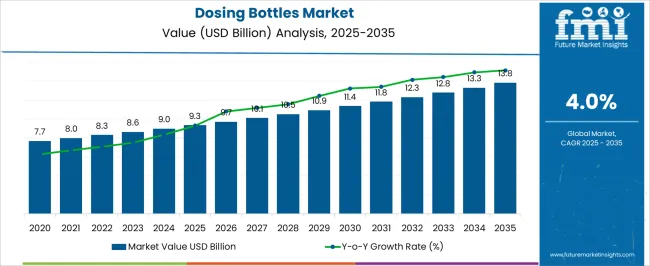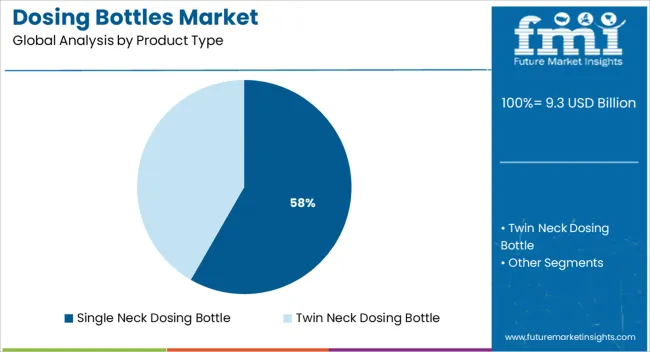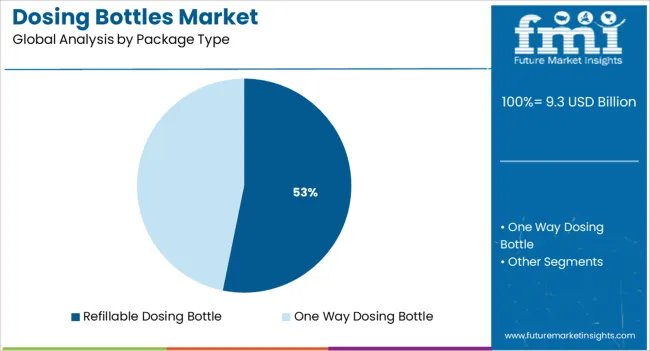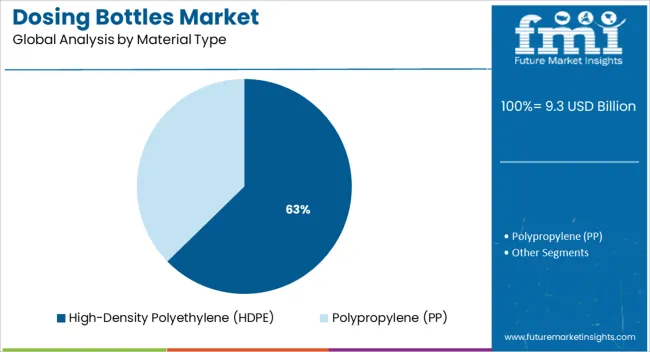The Dosing Bottles Market is estimated to be valued at USD 9.3 billion in 2025 and is projected to reach USD 13.8 billion by 2035, registering a compound annual growth rate (CAGR) of 4.0% over the forecast period.

| Metric | Value |
|---|---|
| Dosing Bottles Market Estimated Value in (2025 E) | USD 9.3 billion |
| Dosing Bottles Market Forecast Value in (2035 F) | USD 13.8 billion |
| Forecast CAGR (2025 to 2035) | 4.0% |
The dosing bottles market is gaining strong momentum as precision dosing and ease-of-use continue to be prioritized across pharmaceutical, agrochemical, and household product applications. Rising demand for accurate volumetric dispensing is influencing packaging innovations aimed at reducing product wastage, improving user convenience, and enhancing shelf-life. Market participants are increasingly adopting smart closure systems and integrated measuring chambers that support consistent dosing across repeated use.
Regulatory requirements around child safety, contamination prevention, and sustainable packaging have also accelerated the shift toward compliant and reusable dosing formats. Manufacturers are favoring recyclable materials and refillable designs to align with global sustainability goals.
In parallel, e-commerce and direct-to-consumer distribution models are creating demand for tamper-evident, leak-proof, and lightweight dosing bottles that ensure product integrity during last-mile delivery. As dosing precision becomes essential across more applications, the market is expected to expand through advancements in design engineering, automation, and bio-based material integration.
The market is segmented by Product Type, Package Type, Material Type, and Application and region. By Product Type, the market is divided into Single Neck Dosing Bottle and Twin Neck Dosing Bottle. In terms of Package Type, the market is classified into Refillable Dosing Bottle and One Way Dosing Bottle. Based on Material Type, the market is segmented into High-Density Polyethylene (HDPE) and Polypropylene (PP). By Application, the market is divided into Horticulture, Animal Health, Herbal Supplements, Fuel Additives, and Chemicals. Regionally, the market is classified into North America, Latin America, Western Europe, Eastern Europe, Balkan & Baltic Countries, Russia & Belarus, Central Asia, East Asia, South Asia & Pacific, and the Middle East & Africa.

The single neck dosing bottle segment is projected to hold 58.3% of total revenue within the product type category in 2025, establishing it as the leading format. Its dominance is attributed to the simplicity of design that facilitates easy pouring, measurement, and dispensing across a wide range of liquid applications.
The single neck configuration supports user-friendly operation, especially in field and clinical environments where quick and accurate dosing is critical. It is widely adopted in pharmaceutical and agrochemical sectors due to its cost-effectiveness, reduced material usage, and ease of manufacturing.
Additionally, compatibility with standard caps and closures enhances its adaptability across distribution channels. As safety, dosage precision, and product protection remain vital to end users, the single neck format is expected to maintain its leading position supported by continuous design refinement and volume scalability.

Refillable dosing bottles are forecast to capture 53.2% of market revenue in 2025 within the package type category, making them the preferred packaging format. Their leading position is driven by rising sustainability mandates and circular economy goals that encourage the use of reusable packaging across pharmaceutical and chemical sectors.
These bottles enable multiple-use cycles, reducing the volume of plastic waste generated and appealing to environmentally conscious consumers and institutional buyers. Manufacturers have responded with durable, chemically resistant bottles featuring easy-to-clean components and leak-proof seals.
Refill-friendly design is also aiding logistics efficiency by allowing concentrates or bulk formulations to be distributed with fewer packaging units. As brand owners aim to meet ESG targets and reduce packaging carbon footprint, refillable dosing systems are being increasingly integrated into product portfolios, reinforcing this segment’s growth trajectory.

High-density polyethylene HDPE is expected to dominate the material segment with a 62.7% revenue share in 2025. This leadership is driven by HDPE’s superior chemical resistance, flexibility in molding, and compliance with stringent packaging safety regulations.
It is extensively used in manufacturing dosing bottles for pharmaceutical, industrial, and household applications due to its durability, lightweight properties, and recyclability. HDPE’s compatibility with various closures, including child-resistant caps and dosing chambers, has enhanced its utility across dosing bottle formats.
Additionally, advancements in resin formulations are improving clarity and impact resistance, further expanding HDPE’s functional range. With sustainability concerns pushing for the use of mono-material recyclable packaging, HDPE remains the preferred material choice for high-performance and cost-effective dosing solutions across global markets.
Packaging plays an important role in order to protect and preserve the product during transportation and usage. In some cases, the exact amount of dosage is considered as an important factor for the user which is not possible in every type of packaging solution.
Therefore, in order to remove this issue many manufacturers and consumer are shifting their focus towards dosing bottles.
Dosing bottles are a user friendly product which works from every position. It automatically levels the liquid in the dosing chamber to correct the measured amount and dispense a specific amount of liquid which is required.
These bottles does not consist of different parts that should be mounted or assembled on the bottle, but it is a single integrated system. Moreover, it consists of two chambers, wherein one is used for storing liquid and the other is used as dispensing option, it requires a single squeeze of the bottle in order to fill the dispensing chamber.
Furthermore, these bottles are available with tamper evident closure with or without a child resistant cap. Brand owner has the facility to advertise and promote on the product, as it provide a great amount of creativity with regards to color, shape and design. Large flat labelling and printing area is available. These bottles are capable of silk screening and hot stamping.
The global dosing bottles market is segmented on the basis of product type, package type, material type and application type. On the basis of product type, global dosing bottles market is segmented into single neck dosing bottle and twin neck dosing bottle, wherein, twin neck dosing bottle is expected to account for more than half of the total market value and volume share.
On the basis of package type, global dosing bottles market can be segmented into refillable dosing bottle and one way dosing bottle in which refillable dosing bottle is expected to gain traction due to its reusability feature. On the basis of material type, global dosing bottles market is segmented into, high-density polyethylene (HDPE) and polypropylene (PP), where in polypropylene is used to manufacture the cap of the dosing bottle.
On the basis of application, global dosing bottles market is segmented into horticulture, animal health, herbal supplements, fuel additives and chemicals.
One of the significant factors towards the growth of the global dosing bottles market is the increasing health conscious individuals towards the consumption of health supplements. Moreover, rising concern towards fuel efficiency, in order to avoid problems such as rough idling, weak acceleration, stumbling and stalling is expected to drive the growth of the dosing bottles market.
Another substantial reason towards the growth dosing bottles market is the dispensing of the exact amount of liquid as overdosing is impossible in dosing bottles. However, the stringent government regulation towards the use plastic is expected to hinder the growth of dosing bottles market.
Due to the use of one way dosing bottle, disposal of waste is an environmental concern, moreover, the toxic waste from the manufacturing plants of dosing bottles and raw material is expected to hinder the growth of the dosing bottles market, as it is affecting the environment as well as the household those are residing around these plants.
Moreover, the wide availability and consumer inclination towards a conventional form of dosing solution is expected to obstruct the growth of the dosing bottles market.
Geographically, the global dosing bottles market is segmented into North America, Latin America, Europe, Asia Pacific (APAC) and Middle East & Africa (MEA). The global dosing bottles market is expected to witness a steady CAGR over the forecast period of 2020 to 2025. North America is expected to account for largest market share in the dosing bottles market due to the increasing health concern among sindividuals.
Moreover, agriculture sector in India and China is expected to account for more than half in the market share of global agriculture industry, therefore, Asia-Pacific is expected to be a lucrative region towards the growth of the global dosing bottles market.
Some of the major players identified across the globe in the dosing bottles market are Cambrian Containers, Bettix Ltd, NilocG Aquatics, The Cary Company, Aquarium Plant Food UK, iBottles, United States Plastic Corporation, Industrial Container and Supply Company and Pont Europe.
The research report presents a comprehensive assessment of the market and contains thoughtful insights, facts, historical data, and statistically supported and industry-validated market data. It also contains projections done using a suitable set of assumptions and methodologies.
The research report provides analysis and information according to categories such as market segments, geographies, type, machine size and end use.
The global dosing bottles market is estimated to be valued at USD 9.3 billion in 2025.
The market size for the dosing bottles market is projected to reach USD 13.8 billion by 2035.
The dosing bottles market is expected to grow at a 4.0% CAGR between 2025 and 2035.
The key product types in dosing bottles market are single neck dosing bottle and twin neck dosing bottle.
In terms of package type, refillable dosing bottle segment to command 53.2% share in the dosing bottles market in 2025.






Our Research Products

The "Full Research Suite" delivers actionable market intel, deep dives on markets or technologies, so clients act faster, cut risk, and unlock growth.

The Leaderboard benchmarks and ranks top vendors, classifying them as Established Leaders, Leading Challengers, or Disruptors & Challengers.

Locates where complements amplify value and substitutes erode it, forecasting net impact by horizon

We deliver granular, decision-grade intel: market sizing, 5-year forecasts, pricing, adoption, usage, revenue, and operational KPIs—plus competitor tracking, regulation, and value chains—across 60 countries broadly.

Spot the shifts before they hit your P&L. We track inflection points, adoption curves, pricing moves, and ecosystem plays to show where demand is heading, why it is changing, and what to do next across high-growth markets and disruptive tech

Real-time reads of user behavior. We track shifting priorities, perceptions of today’s and next-gen services, and provider experience, then pace how fast tech moves from trial to adoption, blending buyer, consumer, and channel inputs with social signals (#WhySwitch, #UX).

Partner with our analyst team to build a custom report designed around your business priorities. From analysing market trends to assessing competitors or crafting bespoke datasets, we tailor insights to your needs.
Supplier Intelligence
Discovery & Profiling
Capacity & Footprint
Performance & Risk
Compliance & Governance
Commercial Readiness
Who Supplies Whom
Scorecards & Shortlists
Playbooks & Docs
Category Intelligence
Definition & Scope
Demand & Use Cases
Cost Drivers
Market Structure
Supply Chain Map
Trade & Policy
Operating Norms
Deliverables
Buyer Intelligence
Account Basics
Spend & Scope
Procurement Model
Vendor Requirements
Terms & Policies
Entry Strategy
Pain Points & Triggers
Outputs
Pricing Analysis
Benchmarks
Trends
Should-Cost
Indexation
Landed Cost
Commercial Terms
Deliverables
Brand Analysis
Positioning & Value Prop
Share & Presence
Customer Evidence
Go-to-Market
Digital & Reputation
Compliance & Trust
KPIs & Gaps
Outputs
Full Research Suite comprises of:
Market outlook & trends analysis
Interviews & case studies
Strategic recommendations
Vendor profiles & capabilities analysis
5-year forecasts
8 regions and 60+ country-level data splits
Market segment data splits
12 months of continuous data updates
DELIVERED AS:
PDF EXCEL ONLINE
Competitive Overview of Dosing Bottles Providers
Twin Neck Dosing Bottles Market Size and Share Forecast Outlook 2025 to 2035
Oral Dosing Cup Market Forecast AND Outlook 2025 to 2035
Micro-Dosing Sachet Fillers Market Analysis - Size and Share Forecast Outlook 2025 to 2035
Chemical Dosing Equipment Market Size and Share Forecast Outlook 2025 to 2035
Hydraulic Dosing Pump Market Size and Share Forecast Outlook 2025 to 2035
Bottles Market Analysis - Growth & Forecast 2025 to 2035
PET Bottles Market Demand and Insights 2025 to 2035
PCR Bottles Market Growth - Demand, Innovations & Outlook 2024 to 2034
Beer Bottles Market Size and Share Forecast Outlook 2025 to 2035
Market Share Insights for Beer Bottles Providers
MDPE Bottles Market
Glass Bottles Market Forecast and Outlook 2025 to 2035
Smart Bottles Market Size and Share Forecast Outlook 2025 to 2035
Glass Bottles And Containers Market Size and Share Forecast Outlook 2025 to 2035
Serum Bottles Market Size and Share Forecast Outlook 2025 to 2035
Paper Bottles Market Growth - Demand & Forecast 2025 to 2035
Competitive Overview of Glass Bottles Market Share
Market Positioning & Share in the Serum Bottles Market
Coffee Bottles Market Insights & Industry Trends 2025 to 2035

Thank you!
You will receive an email from our Business Development Manager. Please be sure to check your SPAM/JUNK folder too.
Chat With
MaRIA